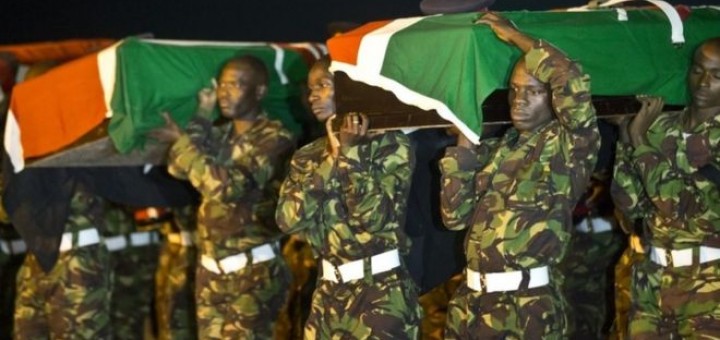A modest meal of rice, mashed potatoes, beans and beef was served for lunch yesterday at the low-key first memorial for the Kenyan soldiers killed when terrorists attacked a KDF base in El Adde, Somalia last year.
About 400 family members, including children and widows of the fallen heroes, congregated at Moi Barracks in Soy near Eldoret. Government officials were conspicuously absent from the barracks that suffered the heaviest casualties.
Father Major George Makau, the Kenya Defence Forces chaplain, delivered the sermon before brief remarks by commanding officers in the barracks and the adjacent Recruits Training School (RTS).
One of the widows was overwhelmed during the service, a sure pointer to the pain of loss among the families that lost their sons, most of them in their 20s.
Commanding officer at the barracks asked families of the departed soldiers never to speak to the media, in what is seen as sustained Government efforts to conceal information about the attack and its aftermath.
“KDF has only one line of communication, which is very formal,” the officer, identified as Major Ekai, said in a warning to the families.
Kenya has been accused of doing little to honour its military personnel, specifically the soldiers who died during the El Adde attack. Western countries said a national day of mourning should have been declared.
None of the survivors spoke about the horrific events of January 15, 2016 where militants overran the KDF base and massacred soldiers in Kenya’s worst military loss in history.
Accounts from people who attended the memorial tell of a dull event in the barracks that has names of the soldiers who have been confirmed to have died. A wreath has been placed on the plaque at the gate bearing names of fallen soldiers.
Every speaker kept off the question of numbers and instead focused on the need to heal and move on. Reports had placed the number of those who died at 141. However, this number was highly understated and today, we can authoritatively report Kenya lost 173 soldier in the deadly attack.
DURING AMBUSH
A second survivor has exclusively told this paper 13 men were taken by the enemy even as another 173 were killed during the ambush.
The Standard managed to get interviews with two survivors who said the militants also made away with thousands of fish, chicken and eggs. In our second account, the survivor who was a commander of one of the units said some of the attackers spoke fluent Swahili, an indication they were Kenyans or had lived in Kenya.
Ben*, who requested to have his real identity protected for fear of reprisals, said it was a Toyota Prado that smashed into the gate, exploding and killing more than 50 men at once. “There were over 2,000 attackers. Make no mistake, we killed more than 500 and that is the story that many people will never know,” he says. According to his account, the El Adde camp had 234 men that morning.
“We had been on standby the whole night after we heard of an impeding attack around 1 am. Around 4am, we thought it was just another threat and we relaxed,” he recalls.
Ben believes their commander did not have any prior intelligence of the attack. Previous reports claim Major Geoffrey Obwoge, the commanding officer, had been forewarned of the attack. After the camp was overrun, Al Shabaab went straight to the kitchen and took away food.
“I was holed in my trench from where I heard them speak. The trench was deep enough to reach my neckline when standing. Due to the huge blast from one of the tanks that had misfired, my trench was covered with dust and I was able to hide. I was lucky because the militants seemed to lose focus on the fight when they saw food,” he says.
“They seemed to be excited about food. One shouted that they would eat officers’ food that day. They loaded the mostly frozen foods and refrigerators into a brown Fiat truck as the assault continued,” he recalls.
Steak and meat on bone available at the camp on the fateful day is estimated to have been 9,000 kilograms, enough to sustain the camp for months, he says.
Suicide bombers launched the assault first, driving into the camp between 4am and 5am. They blew up what different accounts have given as a Toyota Prado before the fighters arrived in lorries for the fierce mortar and guns firepower.
There is a possibility some of the dead soldiers were killed in friendly fire since there was no command after the ambush. He miraculously escaped with only an abrasion from a bullet, before making what he estimates to be about 100 kilometres trek. Five men, including Ben, would walk for three days from dawn to dusk after that Friday. Help came from a plane on a search and rescue mission.
“We agreed that whatever happened, we were better off dying while fighting than allowing ourselves to be captured. So we were ready to shoot,” he said.
One of the men had about 210 bullets on him. Two others had about 100 bullets. They hardly spoke. They survived on two Delmonte packets of juice that one of the survivors picked on his way out. The survivor recalls that one of the men almost gave up and asked to be shot dead just moments before they were rescued.
“We drew their attention by waving t-shirts,” Ben said in an interview. The plane made two trips, moving survivors to Nairobi.

Leave a Reply